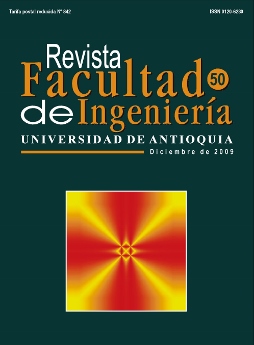Discusión de operadores involucrados en un proceso de calibración mediante algoritmos genéticos para un modelo de calidad del agua de corrientes superficiales trabajando con la herramienta Qual2Kw
DOI:
https://doi.org/10.17533/udea.redin.14933Palabras clave:
algoritmos genéticos, calibración, modelo de calidad del agua, Qual2KwResumen
Al inicio del proceso de calibración de un modelo de calidad del agua, empleando la herramienta computacional Qual2kw que incluye un algoritmo genético como herramienta matemática para calibración, es necesario introducir algunos operadores para el inicio del proceso de calibración que busca la mejor combinación de constantes que representen la realidad de la corriente en cuanto a su calidad de agua. En este trabajo, se realizan recomendaciones generales sobre tres operadores que utiliza el algoritmo genético: la semilla empleada, el número de generaciones y el número de poblaciones; principalmente estos dos últimos resultan importantes, porque implican tiempos computacionales asociados, puesto que una combinación que genere muchas corridas podría no presentar variaciones significativas en el ajuste total del modelo, de tal manera que una combinación "óptima" podría dar buenas soluciones en tiempos razonables. Este trabajo encuentra que efectivamente hay puntos donde la mejora en la calidad del ajuste no aumenta más de un 5% en variación al valor obtenido por la función de error. Por tanto, es posible recomendar ciertos valores para emplear por parte del modelador al momento de emplear esta herramienta.
Descargas
Citas
D. A. Chin. Water quality engineering in natural systems. Ed. Jhon Wiley & Sons. Haboken. New Jersey. 2006. pp. 1-20, 124-186.
R. . Thoman, J. A. Mueller. Principles of surface water quality modeling and control. Ed. Harper Collins Publishers. New York. 1987. pp. 1-23.
G. J. Pelletier, S. C. Chapra, H. Tao. “QUAL2Kw-A framework for modeling water quality in streams and rivers using a genetic algorithm for calibration”. Environmental Modelling & Software. Vol 21. 2006. pp. 419-425. DOI: https://doi.org/10.1016/j.envsoft.2005.07.002
T. S. Metcalfe, P. Charbonneau. “Stellar structure modeling using a parallel genetic algorithm for objective global optimization”. Journal of
Computational Physics. Vol. 185. 2003. pp. 176-193. DOI: https://doi.org/10.1016/S0021-9991(02)00053-0
S. C. Chapra. Surface Water Quality Modelling. Ed. Mc.Graw Hill. New York. 1997. pp. 235-502.
K. Chau. “A review on integration of artificial intelligence into water quality modeling”. Marine Pollution Bulletin. Vol. 52. 2006. pp. 726-733. DOI: https://doi.org/10.1016/j.marpolbul.2006.04.003
P. R. Kannel, S. Lee, Y. S. Lee, S. R. Kanel, G. J. Pelletier. “Application of automated QUAL2Kw for water quality modeling and management in theBagmati River, Nepal”. Ecological Modeling. Vol. 202. 2007. pp. 503-517. DOI: https://doi.org/10.1016/j.ecolmodel.2006.12.033
E. Aras, V. Togan, M. Berkun. “River water quality management model using genetic algorithm”. Environmental Fluids Mechanics. Vol. 7. 2007. pp. 439-450. DOI: https://doi.org/10.1007/s10652-007-9037-4
S. Liu, D. Butler, R. Brazier, L. Heathwaite, S. Khu. “Using genetic algorithms to calibrate a water quality model”. Science of the Total Environment. Vol. 374. 2007. pp. 260–272. DOI: https://doi.org/10.1016/j.scitotenv.2006.12.042
H. J. Martínez. Compresión de imágenes: un enfoque de autómatas celulares evolutivos. Tesis de grado para optar al grado de Magister Scientiarum. Universidad Centro ccidental “Lisandro Alvarado”. 2000. pp. 31-40.
US EPA. Rates, constants, kinetics formulations in surface water quality modeling. 2a ed. 1985. pp. 90-273.
A. W. M. Ng, B. J. C. Perera. “Selection of genetic algorithm operators for river water quality model calibration”. Engineering Applications of Artificial Intelligence. Vol. 16. 2003. pp.529-541. DOI: https://doi.org/10.1016/j.engappai.2003.09.001
Descargas
Publicado
Cómo citar
Número
Sección
Licencia
Derechos de autor 2018 Revista Facultad de Ingeniería

Esta obra está bajo una licencia internacional Creative Commons Atribución-NoComercial-CompartirIgual 4.0.
Los artículos disponibles en la Revista Facultad de Ingeniería, Universidad de Antioquia están bajo la licencia Creative Commons Attribution BY-NC-SA 4.0.
Eres libre de:
Compartir — copiar y redistribuir el material en cualquier medio o formato
Adaptar : remezclar, transformar y construir sobre el material.
Bajo los siguientes términos:
Reconocimiento : debe otorgar el crédito correspondiente , proporcionar un enlace a la licencia e indicar si se realizaron cambios . Puede hacerlo de cualquier manera razonable, pero no de ninguna manera que sugiera que el licenciante lo respalda a usted o su uso.
No comercial : no puede utilizar el material con fines comerciales .
Compartir igual : si remezcla, transforma o construye a partir del material, debe distribuir sus contribuciones bajo la misma licencia que el original.
El material publicado por la revista puede ser distribuido, copiado y exhibido por terceros si se dan los respectivos créditos a la revista, sin ningún costo. No se puede obtener ningún beneficio comercial y las obras derivadas tienen que estar bajo los mismos términos de licencia que el trabajo original.










 Twitter
Twitter